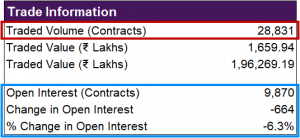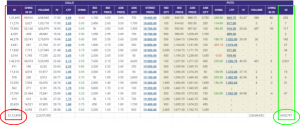Chapter 3
Swipe right, show ‘open interest’
Before we learn what open interest is, let’s spend a minute discussing volume.
What is Volume?
If you have invested or traded in shares, chances are you might have heard of ‘volume’. Volume means the number of shares traded. So, if a buyer buys 100 shares and a seller sells those 100 shares, the volume is 100 shares (not 200).
Illustration 1: Volume in Reliance Industries (equity)

The above image shows that a total of about 30.4 lakh shares of Reliance Industries were traded on 17 August 2022. The next day (i.e. on 18th), the volume counter will start from zero. So each day, when the market opens, the volume counter resets to zero and rises from there as the shares get traded.
Price-Volume analysis
The volume data when used with the price movement, gives interesting insights into market perception.
Table 1: Price and volume analysis
| Price | Volume | Market Direction |
| Increase | Increase | Bullish |
| Decrease | Increase | Bearish |
| Increase | Decrease | Bullish trend could halt or reverse |
| Decrease | Decrease | Bearish trend could halt or reverse |
Now with this context, let’s understand what is open interest in options trading.
What is Open Interest?
Open interest or OI is the total number of contracts of an option that are currently open (or outstanding). In the image below, look at the data highlighted in blue.
Illustration 2: OI in Reliance Industries 2700 Call option

It shows that a total of 9,870 contracts of Reliance Industries’ 2700 call option are open as on 17 August 2022. This is the open interest.
When does OI change?
On 18 August, if a buyer and seller both exit one contract, then the above OI will decrease to 9,869 contracts. Or if a buyer and seller add one new contract, the OI will increase to 9,871. In the above illustration, the change in OI is -664 contracts. It means 664 more contracts got closed than were opened. And thus the reduction in OI.
Any increase or decrease in the OI stacks up on the previous day’s OI. This is unlike volume, which resets every day (marked in red above).
When does OI not change?
On a normal trading day, if a buyer or seller passes on one existing contract to a new seller or buyer, the OI remains unchanged. This is because no new contract is added. Overall, the changes in OI continue till the expiry of the contract.
How to use OI data for analysis?
Just like volume data, using OI data with the price movement can help you gauge market sentiment.
Table 2: Price and OI analysis
| Price | OI | Interpretation | Market sentiment |
| Increase | Increase | Long built-up | New bulls have entered the market,
the uptrend could continue |
| Decrease | Increase | Short built-up | New bears have entered the market,
the downtrend could continue |
| Increase | Decrease | Short covering | Existing short traders are closing position and pushing up the price |
| Decrease | Decrease | Long unwinding | Existing long traders are closing position and pushing down the price |
Using OI for support and resistance
In options trading, the sellers are usually considered more powerful. And there are a couple of reasons behind that:
- Option selling (aka. writing) requires bigger capital compared to options buying. Sellers have deep pockets.
- Institutions and high net-worth individuals, who prefer options selling, have superior research capabilities. They are also called ‘smart money’.
Thus, at the strikes with high OI, a large amount of selling is considered to have happened. (Of course, there are an equal number of buyers too. But, as we discussed above, a higher consideration is given to sellers).
The Nifty50 option chain shown below is captured when Nifty50 was at 17,900. The first (red) and last (green) columns show the OI of calls and puts. Let’s dig deeper.
Illustration 3: Nifty OI data on a option chain

- The 18,000 call option (horizontal red box) has the highest OI as well as shows a positive change in OI. This suggests that maximum calls are sold at this strike because sellers do not expect Nifty50 to rise above 18000, till the expiry. So this could act as the resistance (what’s resistance? Read below).
- Similarly, the 17,800 put option (horizontal green box) has the highest OI as well as shows a positive change in OI. This suggests that maximum puts are sold at this strike because sellers do not expect Nifty50 to fall below 17800, till the expiry. So this could act as the support (read below).
Resistance: A price level around which a rising stock faces pressure. This is because of the presence of a large number of sellers who want to sell around that price.
Support: A price level around which a declining stock witnesses buying interest. This is due to the presence of a large number of buyers who want to buy around that price.
Ideally, you should confirm the above support and resistance levels with at least one other technique such as:
- Swing lows and highs on price charts
- Fibonacci levels
- Moving averages
- Pivot levels
- Big round numbers (e.g. 18000, 18500)
Support and Resistance levels help traders plan entry and exit points in a trade.
To Conclude:
- Open Interest taken along with price data helps gauge market sentiment for an options contract.
- A negative OI indicates more contracts were closed than opened and vice versa.
- Use OI options chain data to identify the support and resistance levels of an option contract. This can be used to decide when to enter or exit a trade.
So this was a detailed discussion on Open interest. We will see you in the next chapter where we will discuss Put Call Ratios or how to understand the mood of the market.

Test your OQ (Options Quotient)
Take your first step towards financial independence with the right training.



